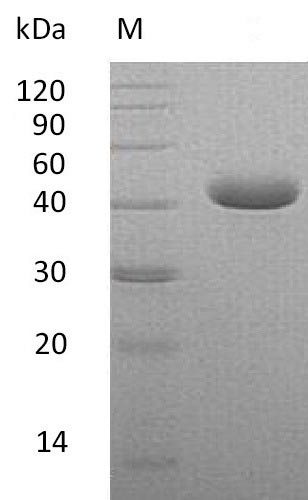Recombinant Human Nectin-4 (NECTIN4) , partial (Active)
CAT:
399-CSB-AP005571HU-03
Size:
50 µg
Price:
Ask
- Availability: 24/48H Stock Items & 2 to 6 Weeks non Stock Items.
- Dry Ice Shipment: No




Recombinant Human Nectin-4 (NECTIN4) , partial (Active)
- CAS Number: 9000-83-3
- Gene Name: NECTIN4
- UniProt: Q96NY8
- Expression Region: 32-351aa
- Organism: Homo sapiens
- Target Sequence: GELETSDVVTVVLGQDAKLPCFYRGDSGEQVGQVAWARVDAGEGAQELALLHSKYGLHVSPAYEGRVEQPPPPRNPLDGSVLLRNAVQADEGEYECRVSTFPAGSFQARLRLRVLVPPLPSLNPGPALEEGQGLTLAASCTAEGSPAPSVTWDTEVKGTTSSRSFKHSRSAAVTSEFHLVPSRSMNGQPLTCVVSHPGLLQDQRITHILHVSFLAEASVRGLEDQNLWHIGREGAMLKCLSEGQPPPSYNWTRLDGPLPSGVRVDGDTLGFPPLTTEHSGIYVCHVSNEFSSRDSQVTVDVLDPQEDSGKQVDLVSASVV
- Tag: C-terminal 6xHis-tagged
- Source: Mammalian cell
- Field of Research: Cell Biology
- Assay Type: Active Protein & In Stock Protein
- Relevance: Nectin-4 (PVRL4) is a type I transmembrane glycoprotein which belongs to the nectin family of Ig superfamily proteins. It contains two Ig-like C2-type domains and one Ig-like V-type domain. PVRL4 seems to be involved in cell adhesion through trans-homophilic and -heterophilic interactions, the latter including specifically interactions with nectin-1. It does not act as receptor for alpha-herpesvirus entry into cells. It is predominantly expressed in placenta, the embryo and breast carcinoma. But it is not detected in normal breast epithelium. The soluble form is produced by proteolytic cleavage at the cell surface (shedding), probably by ADAM17. Mutations in this gene are the cause of ectodermal dysplasia-syndactyly syndrome type 1, an autosomal recessive disorder.
- Endotoxin: Less than 1.0 EU/µg as determined by LAL method.
- Purity: Greater than 95% as determined by SDS-PAGE.
- Activity: Yes
- Bioactivity: Measured by its binding ability in a functional ELISA. Immobilized Anti-Human Nectin-4 mAb-mFc at 2μg/ml can bind Human Nectin-4-His, the ED50 of Human Nectin-4-His is 16.29 ng/ml.
- Length: Partial
- Form: Lyophilized powder
- Buffer: Lyophilized from a 0.2 μm filtered 20 mM PB, 150 mM NaCl, pH 7.4
- Reconstitution: We recommend that this vial be briefly centrifuged prior to opening to bring the contents to the bottom. Please reconstitute protein in deionized sterile water to a concentration of 0.1-1.0 mg/mL.We recommend to add 5-50% of glycerol (final concentration) and aliquot for long-term storage at -20℃/-80℃. Our default final concentration of glycerol is 50%. Customers could use it as reference.
- Function: Seems to be involved in cell adhesion through trans-homophilic and -heterophilic interactions, the latter including specifically interactions with NECTIN1. Does not act as receptor for alpha-herpesvirus entry into cells.; FUNCTION
- Molecular Weight: 35.3 kDa
- Storage Conditions: The shelf life is related to many factors, storage state, buffer ingredients, storage temperature and the stability of the protein itself. Generally, the shelf life of liquid form is 6 months at -20℃/-80℃. The shelf life of lyophilized form is 12 months at -20℃/-80℃.
